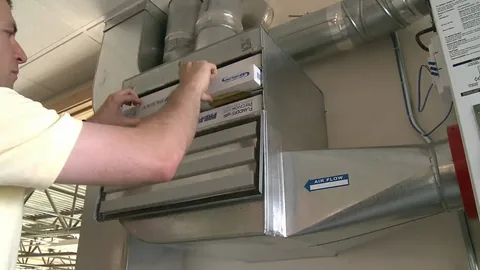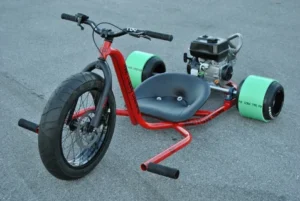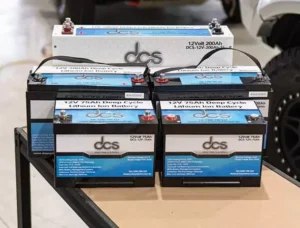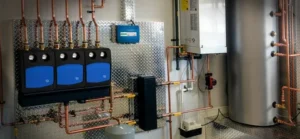Air heat recovery involves transferring heat from the outgoing stale air to the incoming fresh air, enhancing both indoor air quality and energy efficiency. This process retains most of the heat that would typically be lost through ventilation, making it an environmentally friendly alternative. By recovering heat, these systems reduce the energy needed to warm incoming air, leading to lower heating costs. There are various types of systems available, each suited to different climate conditions and household requirements. Properly selected and installed, an air heat recovery system can significantly contribute to a more comfortable and energy-efficient home.
Advantages of Using a Heat Exchange Ventilation System
Energy Efficiency
Heat exchange ventilation systems recover heat from outgoing stale air and transfer it to incoming fresh air, reducing the energy required to heat or cool indoor spaces. This efficiency leads to lower energy bills and a reduced carbon footprint.
Improved Indoor Air Quality
These systems continuously replace stale air with fresh, filtered air, reducing indoor pollutants, allergens, and odors. This creates a healthier environment for occupants, especially in homes or buildings with limited natural ventilation.
Humidity Control
Certain systems, like Energy Recovery Ventilators (ERVs), help manage indoor humidity levels, preventing excessive dryness or moisture buildup, which can lead to mold or respiratory issues.
Reduced Heating and Cooling Costs
By recycling heat from exhaust air, these systems reduce the load on heating and cooling appliances, leading to cost savings on energy bills over time.
Enhanced Comfort
Heat exchange systems maintain a consistent indoor temperature and fresh airflow, ensuring a comfortable living or working environment year-round.
Noise Reduction
Unlike traditional ventilation methods, these systems don’t rely on opening windows, which helps minimize noise intrusion from outside.
Eco-Friendly Operation
Lower energy consumption translates to reduced greenhouse gas emissions, making heat exchange systems a more environmentally friendly choice.
Compliance with Building Codes
Many modern building regulations require adequate ventilation systems. Heat exchange systems often meet or exceed these standards, making them a practical choice for new constructions or renovations.
Low Maintenance Requirements
With regular filter replacements and occasional inspections, heat exchange systems are relatively low-maintenance compared to other HVAC solutions.
Versatility and Adaptability
Heat exchange systems are available in various models and sizes, making them suitable for a wide range of applications, from residential homes to commercial and industrial buildings.
By leveraging these benefits, a heat exchange ventilation system provides a sustainable, efficient, and comfortable solution for indoor air management.
Varieties of Air Heat Recovery Systems
When considering air heat recovery, it’s essential to choose a system that meets your specific needs, taking into account your local climate and indoor air requirements. The two primary types of heat recovery systems are Heat Recovery Ventilation (HRV) systems and Energy Recovery Ventilation (ERV) systems, each offering distinct advantages depending on the conditions of your environment.
Heat Recovery Ventilation (HRV) Systems
HRV systems are designed to operate efficiently in colder climates. They recover heat from outgoing stale air and use it to warm incoming fresh air without transferring moisture. This feature makes HRV systems particularly effective in regions where maintaining a comfortable indoor temperature is a priority during the winter months. These systems help reduce heating costs while ensuring the air inside remains fresh and clean.
Energy Recovery Ventilation (ERV) Systems
ERV systems go a step further by transferring both heat and moisture between incoming and outgoing air. This functionality makes ERVs an excellent choice for areas with high humidity levels, as they help maintain balanced indoor humidity. By preventing excessive dryness in the winter and reducing moisture buildup in the summer, ERVs create a more comfortable and healthier indoor environment.
Comparing HRV and ERV Systems
The decision between an HRV and an ERV system depends on your local climate and specific requirements. HRV systems excel in cold, dry regions where humidity is less of a concern, while ERV systems are better suited to humid areas where managing moisture is critical.
By carefully evaluating these options and consulting with a professional if necessary, you can select a heat recovery system that aligns perfectly with your home’s needs, ensuring energy efficiency, comfort, and improved indoor air quality.
Selecting the Appropriate Energy Recovery Heat Exchanger
Choosing the right air exchange or ventilation system involves careful consideration of various factors to ensure it meets your specific needs and optimizes indoor comfort and energy efficiency. Here are the key aspects to evaluate:
Home Size and Layout
The size of your home plays a significant role in determining the capacity of the ventilation system you need. Larger homes require systems with higher airflow capabilities to ensure consistent and effective air exchange throughout the space. Take into account the layout of your home, as multi-level or open-plan designs may require customized solutions for optimal performance.
Climate Conditions
Your local climate is a critical factor when selecting a ventilation system. In colder regions, systems that focus on heat recovery, like HRVs, are ideal for maintaining warmth while improving air quality. For areas with higher humidity, ERV systems that balance heat and moisture are better suited to creating a comfortable indoor environment.
Budget and Energy Efficiency
While staying within your budget is important, also consider long-term savings. Look for systems with high efficiency ratings that reduce energy consumption, even if they have a higher upfront cost. Energy-efficient models not only lower utility bills but also contribute to a greener home.
Noise Levels and Humidity Control
Pay attention to the noise levels of different models, particularly if the system will be installed in living or sleeping areas. Additionally, determine if humidity control is a priority for your household, as this can significantly impact indoor air quality and comfort.
Professional Guidance
Consulting with HVAC professionals is invaluable. They can assess your home’s specifications, provide tailored recommendations, and ensure that the chosen system meets your air circulation, efficiency, and comfort needs.
By carefully evaluating these factors, you can confidently select a ventilation system that enhances your home’s environment and suits your lifestyle.
The Installation Procedure
Preparing your home is the first step, ensuring there’s ample space and compatibility with your electrical system. Decide whether to opt for professional installation or DIY. Professional services offer precision, but a DIY approach can save money if you follow the guidelines closely. During installation, ensure airtight ductwork connections and set the system for optimal airflow. Carefully follow the manufacturer’s instructions for securing and configuring the unit. Pay close attention to mounting brackets, electrical connections, and duct sealing. Verify that the system operates smoothly by running initial tests and making any necessary adjustments. Lastly, ensure the system’s controls are set according to your specific requirements for efficient operation.
Care and Maintenance
Keep your air heat recovery system running efficiently by adhering to a regular maintenance schedule. Clean the system and replace filters every 3-6 months to maintain optimal performance. Schedule annual professional inspections to catch potential issues early and ensure all components are functioning correctly. Additionally, address any minor problems such as reduced airflow or unusual noises promptly to avoid more significant issues later. By staying proactive with your care routine, you ensure the system operates smoothly and extends its lifespan.
Enhancing the Efficiency of the Fresh Air Heat Exchanger
Start by adjusting your heat exchanger’s settings based on seasonal changes. In the colder months, ensure the system is optimized for heat recovery, maximizing its ability to transfer warmth from outgoing stale air to incoming fresh air. During warmer months, set it to maintain a balanced airflow that keeps indoor temperatures comfortable without wasting energy. Regularly review these settings to ensure they are aligned with your home’s climate and needs.
Integrating your fresh air heat exchanger with smart home systems provides an advanced level of control. Using smart thermostats and sensors, you can automate the system to adjust settings based on real-time conditions. For example, sensors can detect changes in indoor air quality or temperature and make automatic adjustments, ensuring optimal air exchange without unnecessary energy consumption. This integration can also help reduce human error and ensure consistent performance without constant monitoring.
Enhancing your home’s insulation is another key strategy to improve the efficiency of your heat recovery system. Well-insulated homes retain temperature better, allowing the heat exchanger to work more effectively by reducing heat loss. This makes the heat recovery process more efficient and less reliant on additional energy to maintain indoor comfort
Routine maintenance is crucial for keeping your heat exchanger at peak performance. Clean or replace filters regularly to ensure the system remains free of debris and functioning optimally. Additionally, ensure that the ductwork is unobstructed to promote good airflow. An annual professional inspection can also help identify and fix any issues early, preventing costly repairs down the road.
By employing these strategies, you can maximize the effectiveness of your fresh air heat exchanger, making it a more efficient and energy-saving system for your home.
Tackling Common Issues
Noise Levels: Verify that the system has been installed correctly. Sometimes, improper installation can lead to unnecessary noise. Consider adding noise-reducing measures like soundproofing materials around the ductwork or installing vibration dampers.
Initial Cost and Return on Investment: While the initial expenditure might be high, remember that the energy savings over time will often offset this. Look for any available rebates or incentives to reduce upfront costs.
Space Requirements: Ensure there’s adequate space for the system without affecting other home functionalities. If space is a concern, consult with professionals who can recommend more compact models or creative installation solutions.
Temperature and Humidity Control: If the system is not maintaining desired indoor conditions, you may need to fine-tune the settings or verify that all components are functioning correctly.
Filter Maintenance: Regularly check and clean or replace filters. A clogged filter can reduce efficiency and lead to higher operational costs.
Professional Assistance: Sometimes, professional help is necessary to diagnose and fix persistent issues. Don’t hesitate to seek expert advice if you encounter problems that you cannot resolve on your own.
Understanding air heat recovery and making informed decisions about the appropriate system can lead to notable benefits for homeowners. These systems significantly enhance indoor air quality and contribute to energy efficiency, ultimately reducing heating costs. Installation can be approached either professionally or through a well-informed DIY process, ensuring the system is optimally set up for performance. Regular maintenance, including filter replacement and professional inspections, is crucial for sustained efficiency and longevity of the system. Additionally, integrating smart home technologies and improving home insulation can further optimise the system’s effectiveness. By addressing common issues proactively and seeking professional advice when necessary, homeowners can maximise the advantages of their air heat recovery system.
FAQS
What is air heat recovery, and how does it work?
Air heat recovery is a process where a heat recovery ventilation (HRV) system captures heat from outgoing stale air and transfers it to incoming fresh air. The system uses a heat exchanger to retain warmth during colder months or remove heat during warmer months, improving energy efficiency while ensuring fresh air circulation.
What are the benefits of using an air heat recovery system at home?
The benefits include:
- Energy efficiency: Reduces heating and cooling costs by reusing heat.
- Improved indoor air quality: Continuously supplies fresh air while removing stale air.
- Humidity control: Helps maintain balanced humidity levels, preventing mold and condensation.S
- Comfort: Ensures a steady temperature and fresh airflow throughout the home.
Is air heat recovery suitable for all climates?
Yes, air heat recovery systems can be adapted for most climates:
- In colder climates, HRVs retain heat from outgoing air.
- In humid climates, energy recovery ventilation (ERV) systems also manage moisture, enhancing comfort. Your choice depends on your regional climate and indoor air quality needs.
Can I install an air heat recovery system in an existing home?
Yes, HRV systems can be retrofitted into existing homes. However, installation may require adjustments to your home’s ductwork and ventilation layout. Consulting a professional ensures a seamless integration and optimal system performance.
What should I consider when choosing an air heat recovery system?
Key factors to consider:
- Capacity: Ensure the system can handle your home’s air exchange needs, typically measured in cubic feet per minute (CFM).
- Efficiency: Look for systems with high heat recovery efficiency ratings.
- Noise levels: Opt for quieter units if sound is a concern.
- Climate: Choose between HRV and ERV systems based on your regional conditions.
How can I maintain my air heat recovery system for long-term efficiency?
- Filter cleaning: Clean or replace filters every 3-6 months to maintain airflow.
- Duct inspection: Check ducts for blockages or leaks annually.
- Heat exchanger maintenance: Clean the exchanger to prevent dirt buildup.
- Professional servicing: Schedule annual maintenance to ensure all components are functioning efficiently. Regular upkeep prolongs the system’s lifespan and keeps it performing optimally.




